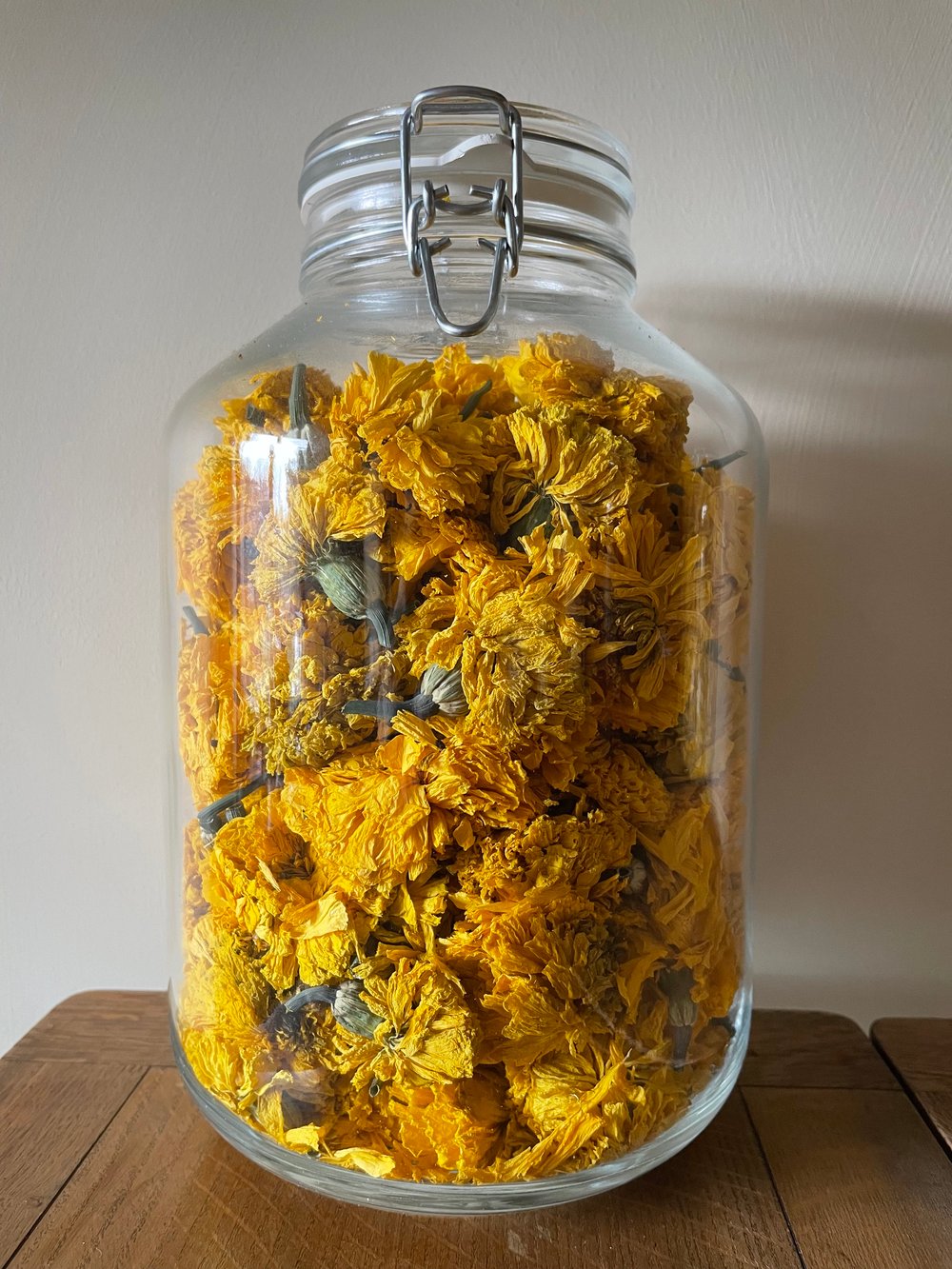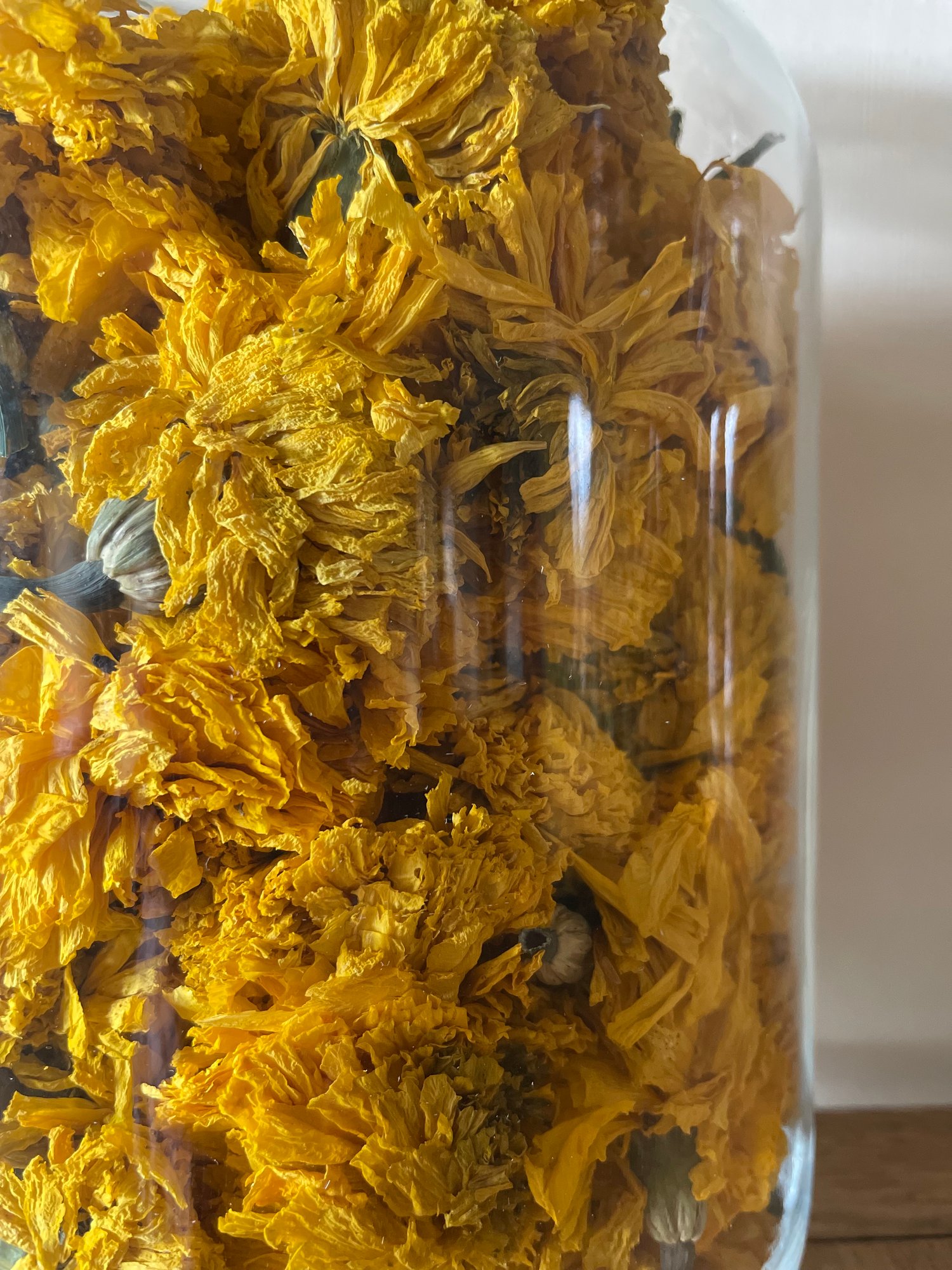Yellow Marigold - British Grown Whole Dried Flowers
£10.00

Marigold flowers shine and glow with a heart-expanding and joyous radiance. Restoring the bodies' physical boundaries, while illuminating of one's sense of self.
Where other herbs offer to move stagnation, marigold shines a bright light guiding us back to our natural state of vitality.
Use for bundle dyeing to create direct prints on textiles and paper, or for steeped in water to create a dyepot for submerging textiles into.
Colours:
Strong, vibrant golden yellows, green-yellows and bronze oranges depending on the dye concentration and choice of mordant.
Ingredients: Whole dried Marigold flowers
Herbal and traditional uses:
Romans and Greeks used the marigold in many rituals and ceremonies, sometimes wearing crowns or garlands made from the flowers. One of its nicknames is "Mary's Gold," referring to the flowers' use in early Catholic events in some countries. Marigold flowers are sacred flowers in India and have been used to decorate the statues of Hindu deities since early times. In Mexico they are used as to line and illuminate pathways to guide spirits home during the Dia de los Muertos.
Medicinally, its antioxidant and anti-microbial qualities are used for healing wounds. The flowers are a rich source of lutein, a carotenoid pigment, which is known to improve eye health.
Marigold ointments are used to soothe skin irritations such as eczema and psoriasis, cooling inflamed sensations, and as a tea, to calm fragmented nerves.
It has been used traditionally as a culinary and medicinal herb, with edible petals which beautify salads and dried are used to colour cooked foods, as well as cosmetics.
In permaculture gardening it is not only a beautiful decorative plant, but also a companion plant, to improve the wellness of neighbouring plants.
Planted by gardeners for protective borders around vegetable patches - to keep away pests and bugs.
Growing:
Grown on a farm in Guernsey using naturaul farming techniques, without the use of synthetic pesticides, herbicides and fungacides.
Recipe:
20% WOF - Light yellow
100% WOF - Deep yellow
50 grams will dye 50 - 250g of fibre light golden yellow to a deep bronze.
To make a dye, add enough water to create the space required for your fibres to move around freely in.
Bring to a simmer and keep at 82 celsius for 30 mins. Strain using a sieve and cheesecloth. Add pre-wetted fibres and simmer for 60 mins or until desired depth of colour achieved. Remove from heat and cool. Rinse, wash and air dry.
Ref Botanical Inks book for further info on dyeing instructions for cellulose/protein fibres, mordanting etc..
For bundle dyeing, follow instructions in my book or using the online workshop recording, available within this online store.
Fastness:
Very good fastness to sunlight, good fastness to rubbing and washing.
Some studies have shown that marigold has better dyeing performance in fastness to washing, perspiration and rubbing than some synthetically dyed fabrics.
Mordants/Modifiers:
Alum brightens yellows on animal fibres and orangey yellows on plant fibres.
3% Iron powder added to pot produces olive greens.
Over-dye with indigo to create warm leaf greens.
A tiny measure of an alkaline such as soda ash will shift yellows to more orangey shades.
Ph sensitivity:
Sensitive to ph levels.
Alkalines shift to more orangey colours.
Transport:
Air courier from Guernsey to English mainland
Shipped from Botanical Inks in Bristol via Royal Mail
Packaging:
Packaged in natural unbleached food grade waxed paper, and secured with natural plant gum paper tape and 100% natural unbleached twine and placed inside a biodegradable corn starch mailer bag - safe for health and environment.


